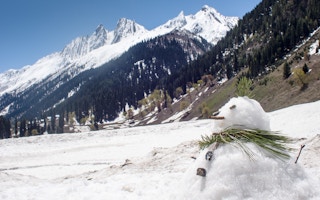For nearly a decade, Mohammad Yousuf has made a living during the winter by giving sledge rides to the tourists who visit the snowy peaks of the Indian Kashmiri mountain town of Gulmarg to enjoy skiing and other winter sports.
But with snowfall in this part of the western Himalayas down by nearly 80 per cent this season, according to scientists, Gulmarg’s slopes are bare and largely deserted, slashing the incomes of people who depend on winter tourism.
The dearth of snow adds to questions being asked about the future of similar winter sports hubs around the world - from Italy’s Apennine Mountains to the Rockies - as climate change alters precipitation patterns and mountain conditions.
“To make a living, I used to charge tourists between 1,000 and 1,500 rupees (US$12-US$18) for a sledge ride, but this season there isn’t any snow on the slopes,” Yousuf, 40, told Context.
Instead, he has been searching out small patches of frozen ground where he can offer visitors a short ride for a cut-rate price of 200 rupees. Many tourists who used to stay for two or three nights now leave after just a few hours, he said.
Many foreign and Indian visitors to the scenic mountains, normally blanketed in deep snow at this time of the year, have cancelled their visits.
“
If the dry spell continues into February, there’s a risk of significantly reduced water levels in the water bodies of Kashmir during the summer. People who depend on these water resources for their livelihoods are also at risk because of this.
Shakil Ahmad Romshoo, vice chancellor, Islamic University of Science and Technology
“I count my loss at 60 per cent in the first week of January, and if there is no snowfall the rest of the month, that percentage will rise,” Yousuf said as he pulled his wooden sledge across a patch of ice.
Ghulam Nabi, 46, president of Gulmarg’s traders’ association, said businesses on average are facing a 55 per cent drop in profits this season - with the possibility of a 70 per cent loss by the end of the winter if more snow does not arrive.
“It will not only affect the businesses in Gulmarg but it will cause a blow to Kashmir’s whole tourism sector,” which had been recovering after the Covid-19 pandemic, he said.
Mukhtar Ahmad, director of the Meteorological Department Kashmir, blamed the unusual shortage of snow in part on the El Niño weather phenomenon, which is affecting precipitation patterns and is expected to last through mid-year.
But warming associated with climate change is also a growing concern.
“I worry that in the upcoming years, this area will wear a deserted look, leaving us locals with no other option than to move our businesses elsewhere in order to make a living,” Nabi said.
Declining snowfall
Kashmir has seen a slow but steady decline in winter snowfall over the past few decades, mainly due to rising temperatures, said Shakil Ahmad Romshoo, a scientist and vice chancellor of the Islamic University of Science and Technology in Kashmir.
That is affecting not just winter tourism but the region’s agriculture, including key crops such as apples and saffron, he added.
“If the dry spell continues into February, there’s a risk of significantly reduced water levels in the water bodies of Kashmir during the summer,” he said.
“People who depend on these water resources for their livelihoods are also at risk because of this.”
Tourism accounts for about 7 per cent of Jammu and Kashmir’s gross domestic product (GDP), according to the tourism department of the Indian-administered territory, and about 70,000 people have jobs linked to the industry.
Many are already feeling the pain in what should be peak season.
Abdul Rashid, 45, runs a tea stall at Gulmarg hill station, selling steaming cups of an aromatic traditional Kashmiri tea, known as kehwa, to tourists.
But Rashid’s 17-km (10-mile) daily trip to Gulmarg, from his home in Kalantra, is barely paying off this winter, with business down by half.
“The climate change in the area is causing havoc on my business,” said Rashid, the sole breadwinner for his family of six.
Farhat Naik, a 30-year-old Gulmarg snowboarding instructor, said the lack of snow has dried up his bookings, particularly with foreign tourists who normally flock to the area for snowboarding and skiing on some of the world’s highest slopes.
More than 90 per cent of his bookings have been cancelled due to the lack of snow, he said, with skiers now changing plans and heading to places such as Italy, Canada and Japan instead.
Adapting tourism and farming to Kashmir’s warming climate will require planning, with new strategies specific to each threatened part of the economy, including forestry and irrigation, said Romshoo, of the Islamic University.
But such plans are yet to be put in place, he added.
Rashid, the tea vendor, said this season’s snow shortage made him worried about the years ahead.
“I lack the resources to launch a new business and if things stay the same I will be left with no source of income to feed my family,” he said.
This story was published with permission from Thomson Reuters Foundation, the charitable arm of Thomson Reuters, that covers humanitarian news, climate change, resilience, women’s rights, trafficking and property rights. Visit https://www.context.news/.










